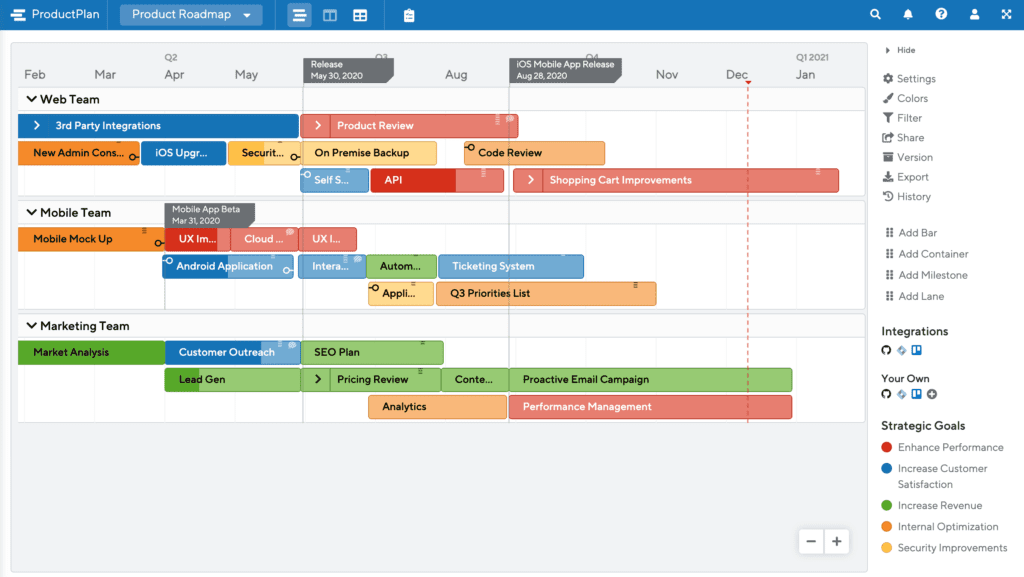A roadmap template can serve as a helpful guide for product managers looking for a broad-strokes idea of what the final output of their roadmap document should look like. But many PMs think of roadmap templates as pre-formatted documents — already developed such that they need only to drop in the details.
But describing roadmap templates in this way is actually a misnomer. That’s because a roadmap, much like a book manuscript, is always a unique strategic document.
Roadmap Templates Are Models for Inspiration, Not Pre-Formatted Documents Ready for Your Details
The desire to find a roadmap template is understandable. Creating a roadmap from scratch can be a slow and difficult process if you are using the wrong tools, as most product managers still do. This is one of the reasons that purpose-built roadmap tools are so effective: They can help a product manager create a new roadmap quickly and with minimal manual effort, and update it anytime just as easily.
But the idea of looking for a “roadmap template” — meaning an existing roadmap or one that is pre-formatted with everything you’ll need to drop in your own details — is probably not the most effective way to think of this process. Here’s why.
Look at the screenshot below, which depicts a sample product roadmap template.
As a roadmap template, this sample offers plenty of useful ideas that a product manager can follow for inspiration or for helping to organize and prioritize her own thoughts.
This roadmap template, for example, groups together multiple epics — such as “Security 2.0” and “New Admin Console” — under a common swimlane. In this case, those epics are the responsibility of the “Web Team.” And all of these items are laid out against a set of broad dates, visible by quarter and month, such that a quick glance will also reveal projected start and end periods for each epic under each theme on the roadmap.
The epics are even color-coded according to a “Strategic Goals” legend on the roadmap, so a quick glance will reveal, for example, that all of the green-colored epics are focused on increasing customer satisfaction, and that the purple items are geared toward boosting revenue.
For inspiration in terms of how to organize a roadmap based on goals, timelines, themes, epics, and individual features contained in each epic, such a roadmap template can be a valuable guide.
But in most cases, you cannot simply cut and paste your own details into a sample roadmap template like the one above. After all, your themes, epics, and specific metrics on your legend will almost certainly be different from the ones in this sample roadmap template.
Two Ways to Use a Roadmap Template to Help Improve Your Own Roadmaps
Here are a couple of ways that roadmap templates can both speed the creation of your roadmap and improve their quality and usability.
1. Roadmap templates can be a useful model or a source of inspiration for your own roadmap.
Every roadmap will be a custom document. For that reason, you cannot expect to simply copy an existing roadmap and replace some of its details with your own. In this sense, a roadmap template won’t be much help. (There is one exception to this, however, which we will discuss below.)
But perhaps you are creating your first agile-based roadmap or a multiple-product roadmap, and you are not sure of where to begin or what the final output document should look like. In these cases, roadmap templates can be helpful. Here is a page filled with such sample roadmap templates, all generated using ProductPlan.
Once you’ve viewed these roadmap templates and gleaned some ideas from them, you will be in a much better position to begin crafting your own.
Download the Product Roadmap Kit ➜
2. You can use a roadmap template from your own organization to generate the broad outline of a new roadmap.
This is one exception to the notion that you generally do not want to treat an existing roadmap template as a pre-formatted document to start your own roadmap. If your organization is using the right purpose-built roadmap tool, you will be able to copy an existing roadmap in your organization’s online account and use it to create a new one.
The value in this strategy is that all of the work you or your product colleagues have already done — establishing a set of strategic goals for tracking, applying scores to various initiatives, grouping stories or features under specific epics, etc. — can be automatically transferred into the new roadmap document. So if you want to create a roadmap for a new addition to your product suite, for example, you can leverage all of that work already completed on previous related roadmaps — using these documents as your roadmap templates — rather than having to recreate all of those details again for your new roadmap.
In these senses, roadmap templates can be extremely valuable in helping you draft your own roadmap quickly and easily.




